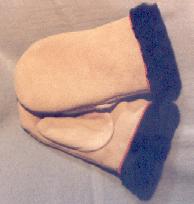
Examples of Native American Mittens and Gloves
Elk Hide Chopper Mittens
(Prindle 1997).
 |
Examples of Native American Mittens and Gloves |
Elk Hide Chopper Mittens
|

|
| Inuit (Eskimo) Woven-grass and Leather Mittens [Miles 1963] |
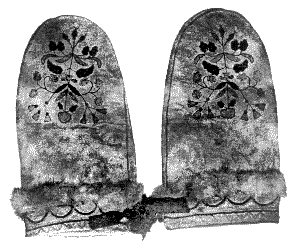
|
|
Mittens, Eastern Cree,
c. 1840's [Johnson 1990] << Cree mittens made of caribou hide, they usually have silk-embroidered floral designs - silk thread replaced animal hair for embroidery in many regions. (City of Sheffield Museum, MGH photograph). |

^^ Moccasins and mittens by Sarah Lavalley, Algonquin, Golden Lake Reserve, Ontario. The moccasins were commissioned directly from Mrs. Lavalley, a tall, refined woman in her late eighties. She included the mittens as a bonus. "The style is a pattern used in 1895, the stitching is the same." To make these objects Mrs. Lavalley used a home-tanned hide obtained from a neighboring German woman "who works to order for us." [Coe 1986]
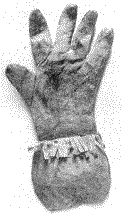 |
| Chippewa Buckskin 'hand' sent as war summons. [Densmore 1979] |
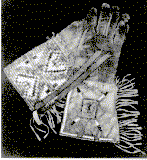
Gauntlet gloves, Teton Dakota type; late nineteenth, early twentieth century. [Hail 1980]
Commercially manufactured leather gloves
with wide cuff of Native-tanned deer hide added, fringe inserted
at juncture; muslin lining; porcupine quill decoration on cuffs;
inside, spider web motif; outside, geometric designs in two-thread,
one-quill, straight sewing, red background, purple, yellow, white;
sinew thread; green silk ribbons.
Heavy 'store' gloves like those the cowboys
wore became popular among Indians as well but were decorated to
make them more handsome. Small stitches and narrow rows make this
an exceptionally fine piece of quillwork. The spider web was a
protective design of the Oglala Dakota.
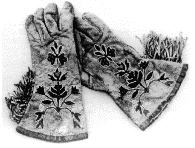
Gauntlet Gloves, Santee Dakota;
third quarter ninteenth century. Collected by Henry D. Banks in
Minnesota, 1880s. HMA purchase 1979. [Hail 1980]
Native-tanned deer hide, embroidered
on backs with small faceted glass seed beads in abstract floral
and butterfly motif outlined in white; interior beading follows
form; colors yellow, light and dark blue, white-core rose, translucent
amber and dark green. The combination of butterfly and floral
motifs is characteristic of Santee work.

|
Text and Graphics
© 1994 - Tara Prindle unless otherwise cited. |